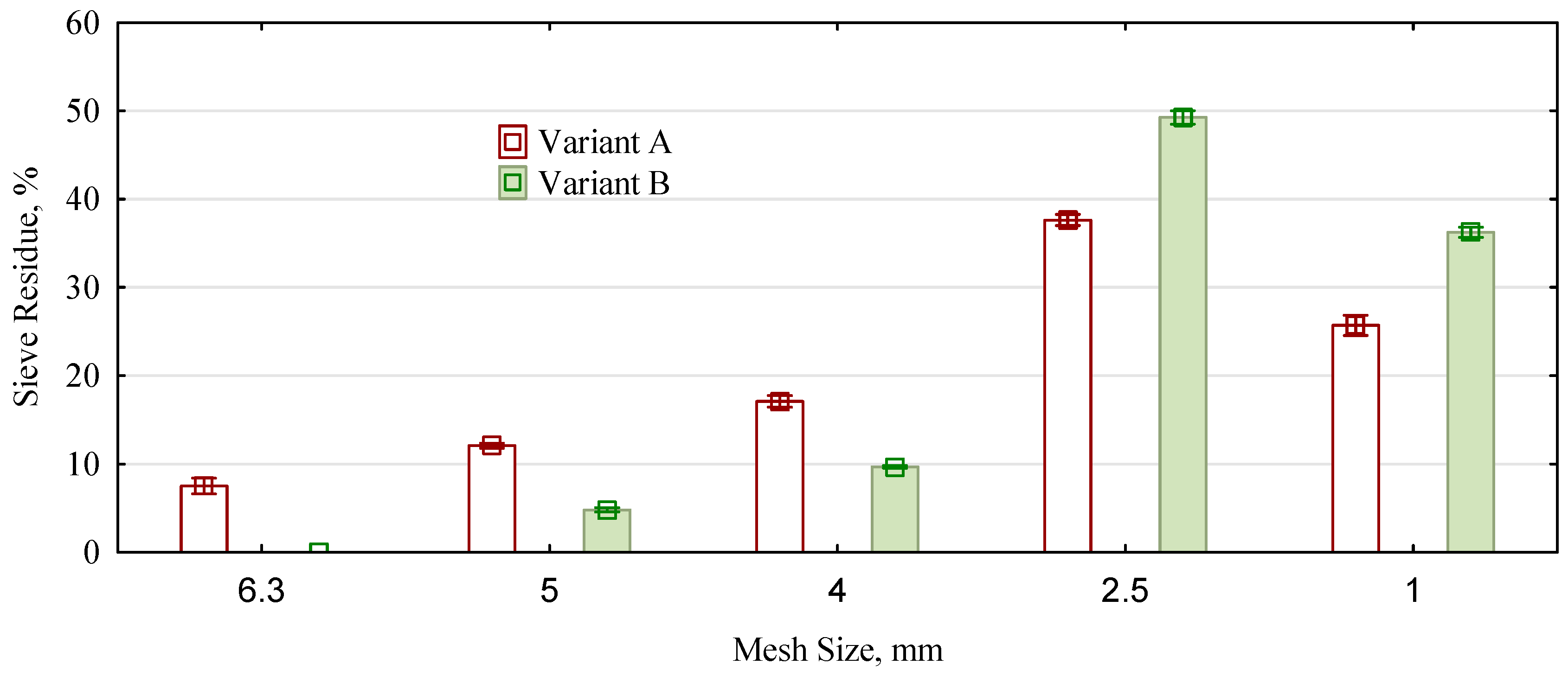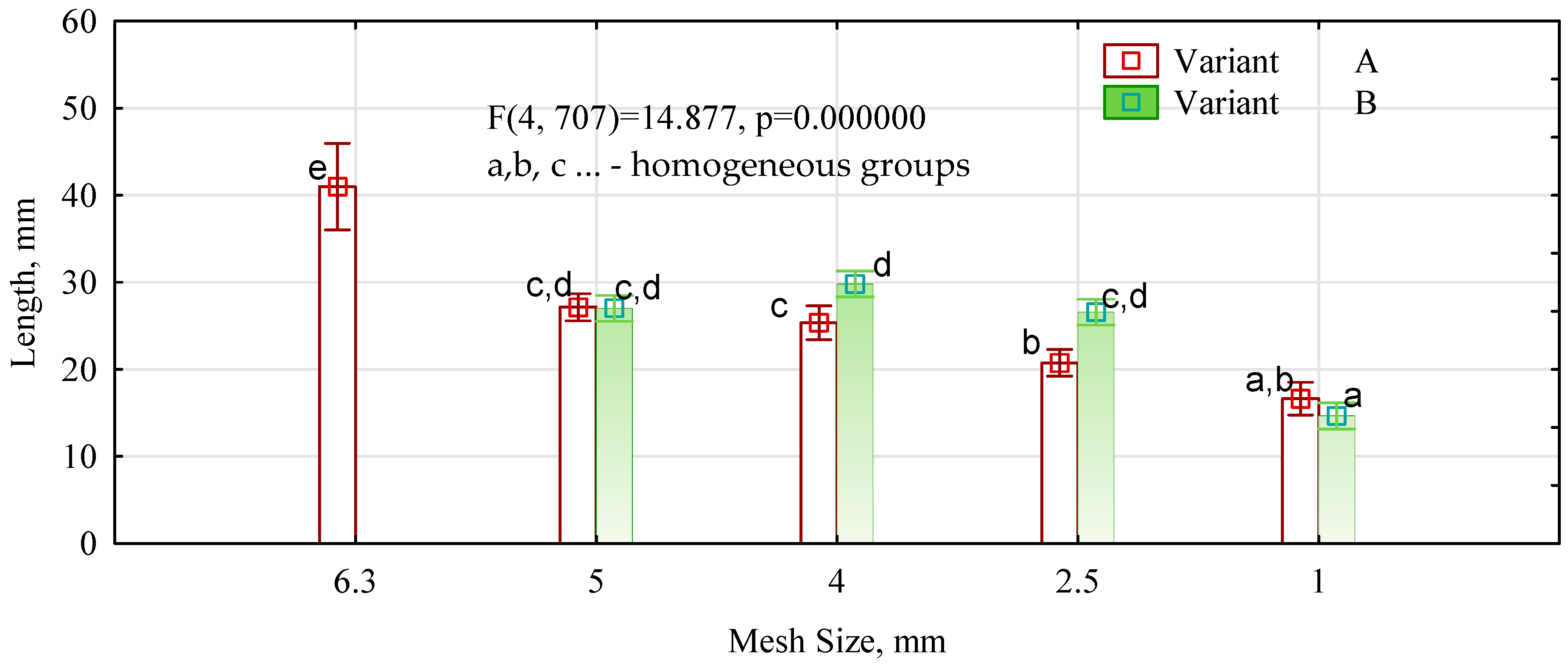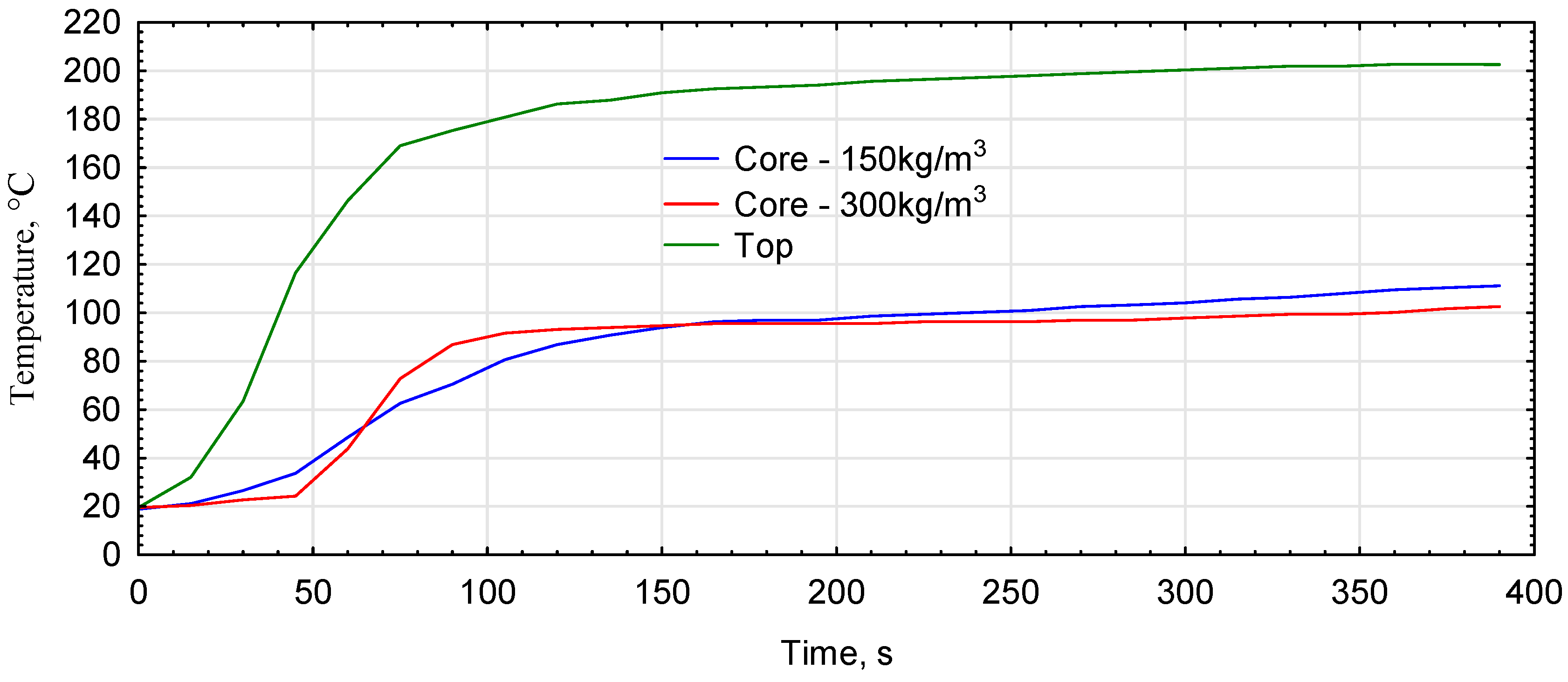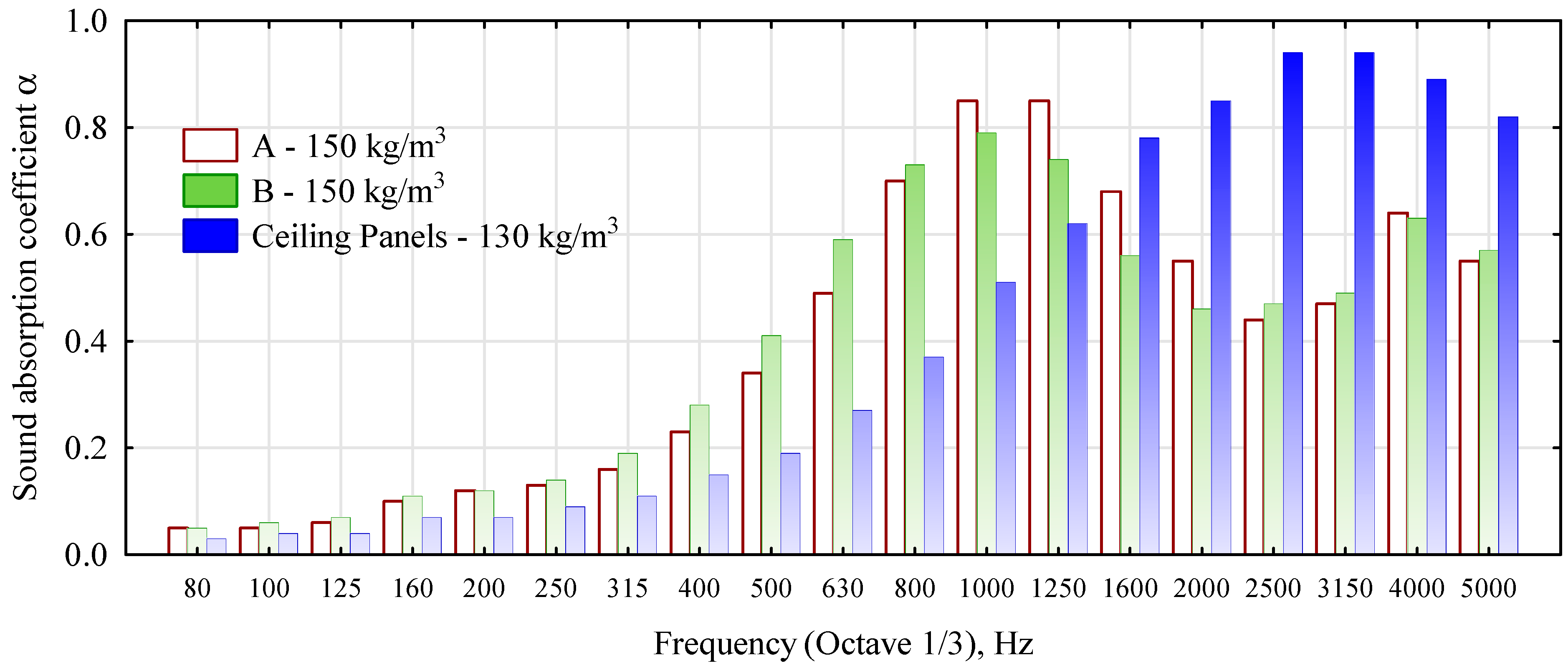Properties of Lightweight Insulating Boards Produced from Triticale Straw Particles
Abstract
1. Introduction
2. Materials and Methods
- -
- The assessments of density and short-term water absorption were carried out on samples with dimensions of 100 × 100 mm and thickness of the boards produced, i.e., 25 mm. The density assessment was carried out based on EN 323 [29], while the short-term water absorption was carried out based on EN ISO 29767 [30].
- -
- The compressive strength and compressive modulus were assessed on specimens measuring 50 × 50 × 25 mm. The compressive stress value was assessed at ten percent relative deformation (EN 826 [31]).
- -
- The evaluation of tensile strength perpendicular to the planes of the board was carried out on samples measuring 50 × 50 × 25 mm (EN 319 [32]).
- -
- Evaluation of the thermal conductivity coefficient was carried out on samples measuring 220 × 252 mm with a manufactured board thickness of 25 mm. The tests were conducted at an assumed temperature of the warm medium of 60 °C. Measurements were made using J-type thermocouples (Thermo Aparatura, Wrocław, Poland). The design and principle of operation are presented in the recent work of Mirski et al. [33].
- -
- The evaluation of the sound absorption coefficient was carried out on circular samples of 100 mm and 30 mm in diameter. The sound absorption coefficient was determined in an impedance tube by EN ISO 10534-2 [34]. The tests were carried out by BOSMAL (Bielsko-Biała, Poland).
- -
- Evaluation of the density profile on the cross-sectional area was carried out on samples measuring 50 × 50 mm using a DAX 6000 laboratory profilometer (GreCon, Hannover, Germany).
3. Results and Discussion
4. Conclusions
- -
- All boards, irrespective of density, are characterized by a very high compressive strength. Compressive strength of 200 kPa is considered very high.
- -
- The boards produced are characterized by a relatively low modulus in compression, with better values obtained when more finely chopped straw is used. This is probably due to the lower susceptibility to sticking of long particles than short particles. However, the property in question does not significantly impact the performance properties. The long stripes compensate very well for the lower glue consumption by half for the other properties.
- -
- Despite their low density, the manufactured boards have a very high tensile strength perpendicular to the planes of boards. Values higher than 0.04 N/mm2 guarantee high resistance to this type of deformation. This type of deformation rarely occurs with the standard use of insulation materials.
- -
- Despite the absence of additional hydrophobic agents, the manufactured boards show very low water absorption. This absorptivity increases only slightly as the density of the board increases. It is, however, significantly lower than a mineral wool panel, although it is higher than a reference panel made from lignocellulose pulp. If this cannot be compensated for in the industrial production of boards made from straw particles, additional hydrophobic agents will have to be introduced into the manufacturing technology.
- -
- Straw particle boards manufactured in a proposed way show high insulation properties, both in terms of thermal and acoustic insulation.
- -
- Larger particles (Variant A) allowed boards with better thermal and acoustic resistance properties to be obtained. On the other hand, a more finely divided straw, with the mass of smaller particles (variant B), allows boards with better mechanical properties to be manufactured. For these reasons, the finer particle boards are suitable as load-bearing insulation boards, e.g., for floors, while the larger-particle boards are suitable as wall insulation boards.
Author Contributions
Funding
Institutional Review Board Statement
Informed Consent Statement
Data Availability Statement
Conflicts of Interest
References
- Dalen, H.; Shorma, T.D. The manufacture of particleboard from wheat straw. In Proceedings of the 30th International Symposium of Washington State University on Particleboard/Composite Materials, Pullman, WA, USA, 16–18 April 1996; pp. 191–196. [Google Scholar]
- Hague, J.; McLauchlin, A.; Quinney, R. Agri-Materials for Panel Products: A Technical Assessment of Their Viability. In Proceedings of the 32nd International Symposium of Washington State University on Particleboard/Composite Materials, Pullman, WA, USA, 31 March–2 April 1998; pp. 151–159. [Google Scholar]
- Han, G.; Zhang, C.; Zhang, D.; Umemura, K.; Kawai, S. Upgrading of Urea Formaldehyde-Bonded Reed and Wheat Straw Particleboards Using Silane Coupling Agents. J. Wood Sci. 1998, 44, 282–286. [Google Scholar] [CrossRef]
- Khristova, P.; Yossifov, N.; Gabir, S.; Glavchev, I.; Osman, Z. Particle Boards from Sunflower Stalks and Tannin-Modified UF Resin. Cellul. Chem. Technol. 1998, 32, 327–337. [Google Scholar]
- Bekhta, P.; Korkut, S.; Hiziroglu, S. Effect of Pretreatment of Raw Material on Properties of Particleboard Panels Made from Wheat Straw. BioResources 2013, 8, 4766–4774. [Google Scholar] [CrossRef]
- Nicewicz, D.; Tarczewski, Z.; Zadn, A.; Pawlicki, J. Method of Producing Particleboards from Cereal Straw. Patent B1202835, 20 October 2003. [Google Scholar]
- Dukarska, D.; Pędzik, M.; Rogozińska, W.; Rogoziński, T.; Czarnecki, R. Characteristics of Straw Particles of Selected Grain Species Purposed for the Production of Lignocellulose Particleboards. Part. Sci. Technol. 2021, 39, 213–222. [Google Scholar] [CrossRef]
- Asdrubali, F.; D’Alessandro, F.; Schiavoni, S. A Review of Unconventional Sustainable Building Insulation Materials. Sustain. Mater. Technol. 2015, 4, 1–17. [Google Scholar]
- Korjenic, A.; Petránek, V.; Zach, J.; Hroudová, J. Development and Performance Evaluation of Natural Thermal-Insulation Materials Composed of Renewable Resources. Energy Build. 2011, 43, 2518–2523. [Google Scholar] [CrossRef]
- Han, G.; Cheng, W.; Manning, M.; Eloy, P. Performance of zinc borate-treated oriented structural straw board against mold fungi, decay fungi, and termites—A preliminary trial. BioResurces 2012, 7, 2986–2995. [Google Scholar] [CrossRef]
- Jelle, B.P. Traditional, State-of-the-Art and Future Thermal Building Insulation Materials and Solutions–Properties, Requirements and Possibilities. Energy Build. 2011, 43, 2549–2563. [Google Scholar]
- Shea, A.; Wall, K.; Walker, P. Evaluation of the Thermal Performance of an Innovative Prefabricated Natural Plant Fibre Building System. Build. Serv. Eng. Res. Technol. 2013, 34, 369–380. [Google Scholar] [CrossRef]
- Zhou, X.; Zheng, F.; Li, H.; Lu, C. An Environment-Friendly Thermal Insulation Material from Cotton Stalk Fibers. Energy Build. 2010, 42, 1070–1074. [Google Scholar] [CrossRef]
- Zhou, Y.; Trabelsi, A.; El Mankibi, M. A review on the properties of straw insulation for buildings. Constr. Build. Mater. 2022, 330, 127215. [Google Scholar] [CrossRef]
- Li, Y.; Zhu, N.; Chen, J. Straw characteristics and mechanical straw building materials: A review. J. Mater. Sci. 2023, 58, 2361–2380. [Google Scholar]
- Tsutomu, I.; Masanao, O. Floor Structure. Patent JP2011219990A, 9 April 2010. [Google Scholar]
- Zhang, L.H.; Su, Q.; Li, J.; Wu, S.; Zhang, F.; Yang, L.; Huang, P.; Zhang, D.; Zheng, D.; Chen, X.; et al. Composite Board of Restructured Bamboos and Straws and Production Method of Composite. Board. Patent CN103264418, 24 April 2013. [Google Scholar]
- Zhang, Z.D.; Yang, X.; Mei, Y.; Hua, C.; Zhou, Y.; Xu, X.; Pan, X.; Chong, M.J.; Li, X. Industrial Production Method of Aldehyde Less Thin Straw Board. Patent CN1785624A, 14 June 2006. [Google Scholar]
- Bach, L.; Domier, K.; Holowach, R. Structural Board of Cereal Straw. Patent CA2234889, 15 April 1998. [Google Scholar]
- Wei, K.; Lv, C.; Chen, M.; Zhou, X.; Dai, Z.; Shen, D. Development and performance evaluation of new thermal insulation material from rice straw using high frequency hot-pressing. Energy Build. 2015, 87, 116–122. [Google Scholar]
- Zhu, W.; Ding, J.; Yu, Z.; Wu, B. Raw Material Selection of Straw Board and Producing Technique Thereof. Patent CN101264624, 12 October 2007. [Google Scholar]
- Yang, H.-S.; Kim, D.-J.; Kim, H.-J. Rice Straw–Wood Particle Composite for Sound Absorbing Wooden Construction Materials. Bioresour. Technol. 2003, 86, 117–121. [Google Scholar] [CrossRef] [PubMed]
- Harvey, H.S. Development of Straw Insulation Board: Fabrication Methods, Structure, Thermal Performance, Massachusetts Institute of Technology. 1997. Available online: https://www.dspace.mit.edu/handle/1721.1/66784 (accessed on 20 May 2023).
- Norford, L.K.; Glicksman, L.R.; Harvey, H.S.; Charlson, J.A. Development of Low-Cost Wheat-Straw Insulation Board. HVACR Res. 1999, 5, 249–263. [Google Scholar] [CrossRef]
- Hussein, Z.; Ashour, T.; Khalil, M.; Bahnasawy, A.; Ali, S.; Hollands, J.; Korjenic, A. Rice Straw and Flax Fiber Particleboards as a Product of Agricultural Waste: An Evaluation of Technical Properties. Appl. Sci. 2019, 9, 3878. [Google Scholar]
- Hareedy Noha, Z.; Nasr El-Sayed, A.; Sadek Ehab, F. Properties and performance of Normal Pressed Rice Straw Thermal Insulation Boards. Int. J. Sci. Eng. Res. 2019, 10, 837–844. [Google Scholar]
- Abdelhamid, S. Requirements of balling chopped rice. J. Soil Agric. Eng. 2021, 12, 615–619. [Google Scholar] [CrossRef]
- Mirski, R.; Banaszak, A.; Fabisiak, E.; Siuda, J. Anatomical properties of straw of various annual plants used for the production of wood panels. Wood Res. 2021, 66, 995–1005. [Google Scholar] [CrossRef]
- EN 323; Wood-Based Panels–Determination of Density. European Committee for Standardization: Brussels, Belgium, 1993.
- EN ISO 29767; Thermal Insulating Products for Building Applications–Determination of Short-Term Water Absorption by Partial Immersion. European Standardization Committee: Brussels, Belgium, 2019.
- EN 826; Thermal Insulating Products for Building Applications–Determination of Compression Behaviour. European Committee for Standardization: Brussels, Belgium, 2013.
- EN 319; Particleboards and Fibreboards—Determination of Tensile Strength Perpendicular to the Plane of the Board. European Committee for Standardization: Brussels, Belgium, 1993.
- Mirski, R.; Dziurka, D.; Trociński, A. Insulation Properties of Boards Made from Long Hemp (Cannabis sativa L.) Fibers. BioResources 2018, 13, 6591–6599. [Google Scholar] [CrossRef]
- EN ISO 10534–2; Acoustics-Determination of Sound Absorption Coefficient and Impedance in Impedance Tubes-Part 2. European Committee for Standardization: Brussels, Belgium, 1998.
- Mirski, R.; Dziurka, D.; Banaszak, A. Properties of Particleboards Produced from Various Lignocellulosic Particles. BioResources 2018, 13, 7758–7765. [Google Scholar] [CrossRef]
- Meng, Y.W.; Chen, L.M.; Xu, J.R.; Zhang, C. Analysis of heat trasfer performance of corn straw board. J. Jilin Agric. Univ. 2019, 41, 483–488. [Google Scholar]
- Xiong, X.; Niu, Y.; Yuan, Y.; Zhang, L. Study on dimensional stability of veneer rice straw particleboard. Coatings 2020, 10, 558. [Google Scholar] [CrossRef]
- Dziurka, D.; Mirski, R. Lightweight Boards from Wood and Rape Straw Particles. Drewno. Pr. Naukowe. Doniesienia. Komun. 2013, 56, 190. [Google Scholar]
- Available online: www.vestaeco.pl (accessed on 20 May 2023).
- Giannotas, G.; Kamperidou, V.; Barboutis, I. Tree bark utilization in insulating bio-aggregates: A review. Biofuel. Bioprod. Biorefin. 2021, 15, 1989–1999. [Google Scholar]
- STEICO Holzfaser-Dämmstoffe: Natürlicher Schutz vor Sommerhitze. Available online: www.steico.com (accessed on 20 May 2023).







| Board Density (kg/m3) | Compression Strength (kPa) * | Modulus of Elasticity in Compression (N/mm2) | Tensile Strength (N/mm2) | |||
|---|---|---|---|---|---|---|
| - | A | B | A | B | A | B |
| 150 | 150 (8.6) | - | 0.132 (0.004) | - | 0.02 (0.001) | - |
| 200 | 201 (11.2) | 200 (6.0) | 0.167 (0.004) | 0.214 (0.004) | - | 0.04 (0.004) |
| 250 | 300 (25.6) | 310 (26.1) | 0.201 (0.005) | 0.291 (0.005) | - | 0.05 (0.008) |
| 300 | 660 (38.6) | 720 (23.0) | 0.512 (0.015) | 0.743 (0.010) | - | 0.06 (0.007) |
| 350 | 980 (66.2) | 1060 (34.8) | 0.950 (0.012) | 1.07 (0.011) | - | 0.10 (0.011) |
| 400 | - | 1770 (105.9) | - | 1.91 (0.106) | - | 0.15 (0.027) |
| 130 ** | 12.3 (0.02) | - | 0.01 (0.001) | |||
| 240 *** | 100 (2.3) | - | - | |||
| Board Density (kg/m3) | Short-Term Water Absorption (kg/m2) | Thermal Conductivity Coefficient λ W/(m·K) | Sound Absorption Coefficient α *** | |||
|---|---|---|---|---|---|---|
| - | A | B | A | B | A | B |
| 150 | 1.34 (0.04) | - | 0.037 (0.001) | - | 0.54 | 0.52 |
| 200 | 1.66 (0.06) | 1.79 (0.23) | 0.046 (0.001) | 0.033 (0.002) | 0.31 | 0.31 |
| 250 | 1.82 (0.08) | 1.82 (0.01) | 0.054 (0.001) | 0.039 (0.001) | 0.18 | 0.19 |
| 300 | 2.00 (0.07) | 1.91 (0.05) | 0.063 (0.003) | 0.047 (0.001) | - | 0.16 |
| 350 | 2.09 (0.07) | 1.96 (0.07) | 0.072 (0.001) | 0.055 (0.002) | - | 0.08 |
| 400 | - | 2.15 (0.18) | - | 0.068 (0.004) | - | 0.06 |
| 130 * | 4.5 | 0.031 | 0.58 | |||
| 240 ** | <1 | 0.050 | - | |||
| 180 **** | <1 | 0.048 | - | |||
Disclaimer/Publisher’s Note: The statements, opinions and data contained in all publications are solely those of the individual author(s) and contributor(s) and not of MDPI and/or the editor(s). MDPI and/or the editor(s) disclaim responsibility for any injury to people or property resulting from any ideas, methods, instructions or products referred to in the content. |
© 2023 by the authors. Licensee MDPI, Basel, Switzerland. This article is an open access article distributed under the terms and conditions of the Creative Commons Attribution (CC BY) license (https://creativecommons.org/licenses/by/4.0/).
Share and Cite
Lesiecki, M.; Kawalerczyk, J.; Derkowski, A.; Wieruszewski, M.; Dziurka, D.; Mirski, R. Properties of Lightweight Insulating Boards Produced from Triticale Straw Particles. Materials 2023, 16, 5272. https://doi.org/10.3390/ma16155272
Lesiecki M, Kawalerczyk J, Derkowski A, Wieruszewski M, Dziurka D, Mirski R. Properties of Lightweight Insulating Boards Produced from Triticale Straw Particles. Materials. 2023; 16(15):5272. https://doi.org/10.3390/ma16155272
Chicago/Turabian StyleLesiecki, Mariusz, Jakub Kawalerczyk, Adam Derkowski, Marek Wieruszewski, Dorota Dziurka, and Radosław Mirski. 2023. "Properties of Lightweight Insulating Boards Produced from Triticale Straw Particles" Materials 16, no. 15: 5272. https://doi.org/10.3390/ma16155272
APA StyleLesiecki, M., Kawalerczyk, J., Derkowski, A., Wieruszewski, M., Dziurka, D., & Mirski, R. (2023). Properties of Lightweight Insulating Boards Produced from Triticale Straw Particles. Materials, 16(15), 5272. https://doi.org/10.3390/ma16155272






